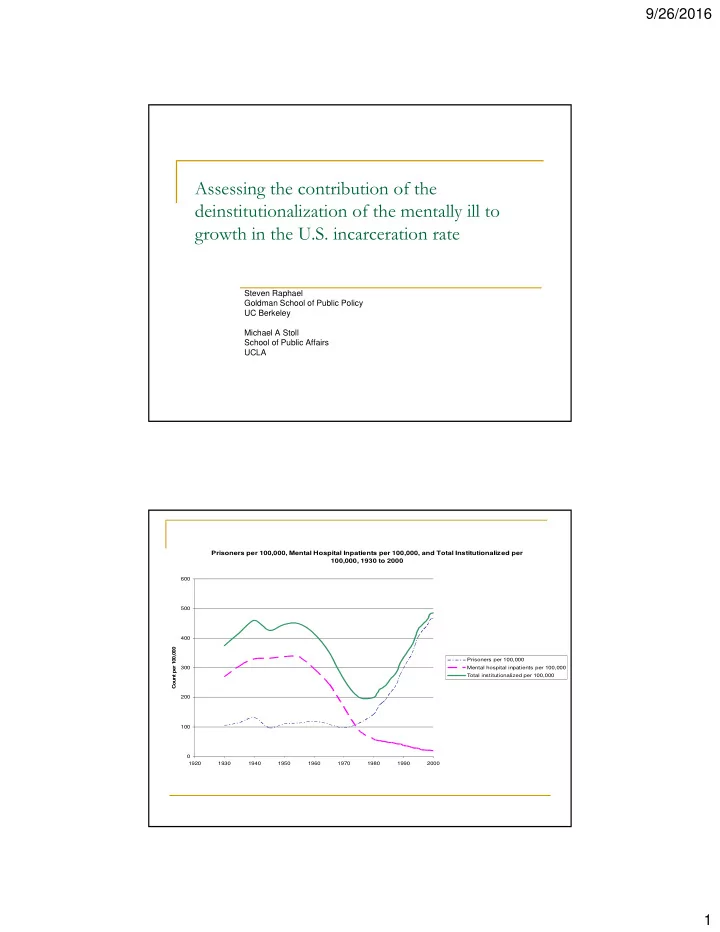

9/26/2016 Assessing the contribution of the deinstitutionalization of the mentally ill to growth in the U.S. incarceration rate Steven Raphael Goldman School of Public Policy UC Berkeley Michael A Stoll School of Public Affairs UCLA Prisoners per 100,000, Mental Hospital Inpatients per 100,000, and Total Institutionalized per 100,000, 1930 to 2000 600 500 400 ount per 100,000 Prisoners per 100,000 300 Mental hospital inpatients per 100,000 Total institutionalized per 100,000 C 200 100 0 1920 1930 1940 1950 1960 1970 1980 1990 2000 1
9/26/2016 Putting an upper bound on the possible contribution of deinstitutionalization to prison and jail growth Characteristics of the mental hospital population at the peak are quite different from those of the incarcerated population then and now. Deinstitutionalization appeared to follow a chronologically selective path, suggesting larger potential impact of latter phases on incarceration Tabulating an upper bound accounting for differences in demographic composition and the misalignment in timing 2
9/26/2016 Two questions with answers that illustrate the compositional differences between the institutionalized populations in 1950 and 2000 How has the overall institutionalization risk (mental hospitals or jail/prison) for those institutionalized in 2000 changed since 1950? How did the overall institutionalization risk for those institutionalized in 1950 change through the end of the century? Institutionalization Rates for Adults 18 to 64 Years of Age Between 1950 and 2000, Actual Rates, Rates Weighted by the 1950 Distribution of Mental Hospital Patients, and Rates Weighted by the 2000 Distribution of Institutionalized Adults 5000 4500 4000 3500 Institutionalized per 100,000 3000 Overall institutionalization rate Weighted by 1950 mental hospital patients 2500 Weighted by 2000 institutionalized 2000 population 1500 1000 500 0 1950 1960 1970 1980 1990 2000 3
9/26/2016 Comparing the demographics of deinstitutionalization and prison growth between 1980 and 2000 92 % of incarceration growth between 1950 and 2000 occurs after 1980 Remaining 8 % occurs during the latter half of the 1970s Measuring deinstitutionalization post-1980 with census data Assume complete deinstitutionalization by 2000 Comparison of the Change in Institutionalization Rates (2000 Institutionalization Minus 1980 Incarceration) to the Mental Hospital Inpatient Rate as of 1980, Black Males 10000 8776 9000 7936 8000 7278 Rate of Change in Rate per 100,000 6794 7000 5790 6000 Inpatient rate 1980 5000 Change in institutionalization rate 4378 4000 2795 3000 2124 2000 1000 488 407 369 382 329 214 243 244 0 18 to 25 26 to 30 31 to 35 36 to 40 41 to 45 46 to 50 51 to 55 56 to 64 4
9/26/2016 Bounding the contribution of deinstitutionalization to incarceration growth between 1980 and 2000 Calculate what the incarceration what would have been in 2000 for demographic subgroups (defined by race, gender, and age) assuming Complete deinstitutionalization between 1980 and 2000 Specific trans-institutionalization rates (one-for-one, one-for-one half, one-for-one quarter) Use 2000 population shares to generate overall counterfactual incarceration rate Actual Incarceration and Institutionalization Rate in 1980 and 2000 and Hypothetical Institutionalization Rates for 2000 Assuming Alternative Trans-institutionalization Parameters 1400 1309 1277 1244 1180 1200 Institutionalized/Incarcerated per 100,000 1000 800 600 400 326 200 0 1980 Incarceration Rate 2000 Institutionalization 2000 hypothetical 2000 hypothetical 2000 hypothetical Rate assuming transfer rate of 1 assuming transfer rate of assuming transfer rate of 0.5 0.25 5
9/26/2016 Summary No more than 13 percent of incarceration growth since 1980 can be attributed to deinstitutionalization. Deinstitutionalization may be responsible for a relatively large proportion of the severely mentally ill population in prisons and jails. For 2000, our prevalence estimates for severe mental illness combined with correctional population totals for that year imply that there are 277,000 severely mentally ill inmates. The bounding exercise gives an upper bound contribution of deinstitutionalization of 144,000. Estimating the transfer rate from mental hospitalization to incarceration Impact of deinstitutionalization on prison growth likely to be heterogeneous Deinstitutionalization has pursued a chronologically-selective path Incarceration risk during the 1980s and 1990s is relatively high due to changes in sentencing policy (Raphael and Stoll 2009) Causality may run in the opposite direction due to State budget constraints (Ellwood and Geutzkow 2009) Policy changes increasing the competing risk of incarceration may divert some from state mental health systems. 6
9/26/2016 Estimates of trans-institutionalization rates for 1950 through 1980 Use data from the one percent PUMS files for 1950, 1960, 1970, and 1980 Construct a panel data set varying by year, state of residence, race, gender, and age. Estimate the model Incarcerat ion hospitaliz ation tsgra tsg sgr sga g tsgra tsgra 7
9/26/2016 Estimates of trans-institutionalization rates for 1980 through 2000 Use data from the 5 percent PUMS files for 1980 and 2000 Cannot separately identify mental hospital inpatients from prison and jail inmates among those in institutionalized group quarters post 1980. By 2000, mental hospital population is trivially small compared to the population of prison and jail inmates (60,000 vs. 2,000,000) Use negative one times 1980 hospitalization rate as a proxy for deinstitutionalization over this period. Use overall-institutionalization rate in 2000 minus 1980 incarceration rate as a proxy for the change in incarceration Incarcerat ion hospitaliz ation _ 1980 gsra gsr gsa g gsra gsra 8
9/26/2016 Bottom line Using trans-institutionalization estimates when data are pooled by gender, our estimates suggest that roughly 4 percent of incarceration growth between 1980 and 2000 is of mentally ill individuals who in past years who have been hospitalized. Using race specific results raises this estimate to 7 percent. In terms of bodies, the estimates suggest a range of 40,000 to 72,000 additional inmates who would have been inpatients. 14 to 26 percent of the incarcerated severely mentally ill population. 9
Recommend
More recommend